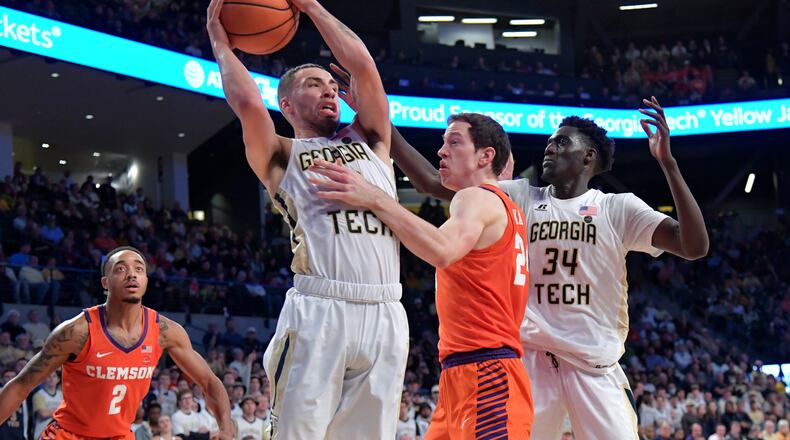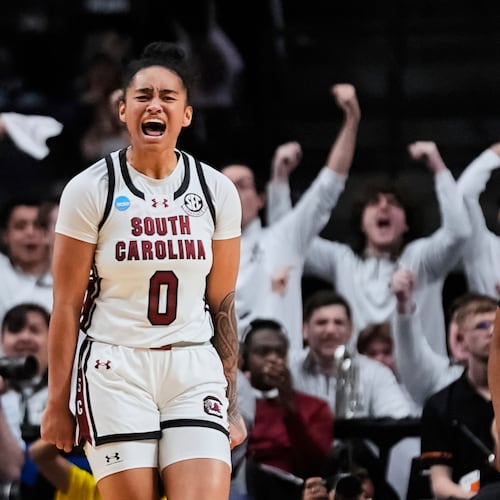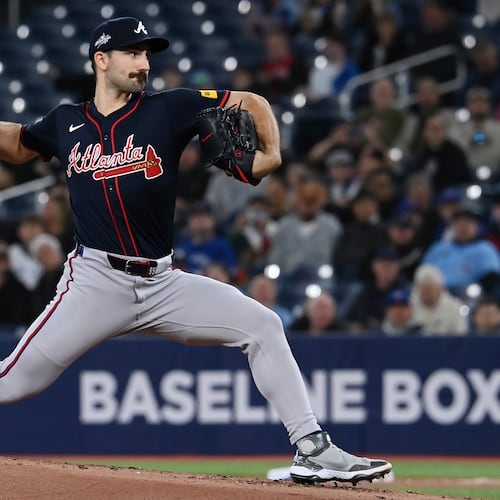Now that he’s back to practicing, Georgia Tech guard Jose Alvarado can laugh. The first days of his rehabilitation from his elbow fracture and dislocation – they were not fun. To develop range of motion, team trainer Richard Stewart pushed on the arm, stiff at a bent angle.
Further, Alvarado’s muscles atrophied as his arm was trapped in a cast.
“Oh, man,” Alvarado said. “Everybody used to make fun of me. I had a little skinny arm.”
The sophomore still is trying to get comfortable with contact, but he’ll take that hurdle over the ones he has already cleared in his recovery.
“I’m telling you, rehab is not fun,” Alvarado said. “It gets you better, though.”
Besides Alvarado, fellow sophomore guard Curtis Haywood can also attest. Sidelined with a stress fracture in his right shin that required surgery to repair, Haywood also is back on the practice court as the Yellow Jackets go through summer workouts.
“We’re both trying to do what we can to get healthy, stay healthy and take us to the (NCAA) tournament,” Haywood said.
To the extent both played last season as freshmen, they exceeded expectations. Haywood started seven consecutive games in the early portion of the non-conference schedule and averaged 30.9 minutes. He scored in double figures in four of those games. In the seven starts, he made 12 of 23 3-point tries (52.2 percent). Feeling soreness in his shin, he sat out six games, then came off the bench for the next seven games, at which point he was put on the shelf for the season.
After the stress fracture was diagnosed, Haywood said doctors told him that, had he kept playing, he would have risked the sort of gruesome fracture that NBA star Paul George suffered in 2014.
“So thank God I stopped playing and didn’t force it and got surgery,” he said.
Haywood had a metal rod inserted in his leg. He said he still feels soreness in his knee (where the rod was inserted), but said he feels like he is getting stronger. Haywood said he surprised himself with his production in the time he played.
“It just clicked,” he said. “This could have been the season for me, and then, when I got hurt, I was like, ‘Wow, I got hurt again (after a broken foot suffered as sophomore in high school).’ It’s crazy. But I guess it’s better now than later on or breaking my leg.”
In the 12 games before the Duke game Feb. 11, when he dislocated his elbow taking a hard fall, Alvarado played 470 out of a possible 485 minutes, 96.9 percent. He played with toughness and energy. He demonstrated proficiency from 3-point range (37 percent shooting) and showed himself a capable distributor. He was not without flaws, as he was sometimes loose with the ball, but gave hope for the future, averaging 12.1 points per game, with a 77-59 assist/turnover ratio in 25 games.
The injury cost him the final seven games of the season.
Now, as he returns, with Ben Lammers and Tadric Jackson graduated and Josh Okogie an early departure for the NBA, he is an unquestioned leader by virtue of his position and experience.
“I think it’s going to be a big role, but I’ve got really great teammates around me,” Alvarado said.
How Alvarado and Crawford play will have a major bearing on Tech’s hopes this winter. If Haywood can give Tech the sort of perimeter punch and defense that he did in his seven-game stretch as a starter, and if Alvarado can take steps on his form as a freshman, it will give coach Josh Pastner some consistency out of a team that probably will struggle to have much in the way of reliability.
Haywood wants to develop his skill as a playmaker, learning to make plays off the dribble for himself and teammates.
“Curt is going to be that dog that picks up (opponents) 94 feet (from the basket), makes big-time shots and keeps everybody in the game,” Alvarado said. “Curt is already a good defender and he’s a knockdown shooter, so he knows his role and he’s going to be really good at it.”
Alvarado is trying to become smarter with the ball to limit turnovers, a major priority for Pastner. He also wants to become more adept from the perimeter. The team set a summer goal for each player to make 10,000 3-pointers in private shooting sessions. (Both the Zelnak Center practice court and McCamish Pavilion are outfitted with a shot-tracking system that calculates makes, misses, shooting arc, depth and left/right variation.)
As of June 29, Alvarado said he had made about 2,500 3-pointers and was making them at a clip around 60 percent. Regarding his injury, he had taken a step when he dove for a loose ball and landed on his elbow with no ill effect.
“I’m just trying to get better overall,” he said. “I’m just trying to show everybody that I’m a better player and the elbow thing is not a big factor of my game.”
About the Author
Keep Reading
The Latest
Featured




